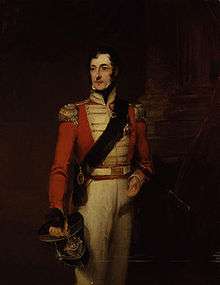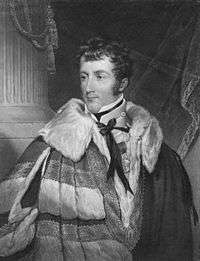Charles Gordon-Lennox, 5th Duke of Richmond
| His Grace The Duke of Richmond KG, PC | |
|---|---|
|
The Duke of Richmond, 1824. | |
| Postmaster General | |
|
In office 11 December 1830 – 5 July 1834 | |
| Monarch | William IV |
| Prime Minister | The Earl Grey |
| Preceded by | The Duke of Manchester |
| Succeeded by | The Marquess Conyngham |
| Personal details | |
| Born |
3 August 1791 Richmond House, Whitehall Gardens, London |
| Died |
21 October 1860 (aged 69) Portland Place, Marylebone, London |
| Nationality | British |
| Political party | Ultra-Tories |
| Spouse(s) |
Lady Caroline Paget (1796–74) |
| Alma mater | Trinity College, Dublin |
Charles Gordon-Lennox, 5th Duke of Richmond and 5th Duke of Lennox, 5th Duke of Aubigny, KG, PC (3 August 1791 – 21 October 1860), styled Earl of March until 1819, was a British soldier, politician and a prominent Conservative.
Background and education
Richmond was the son of Charles Lennox, 4th Duke of Richmond, and the former Lady Charlotte Gordon. He was educated at Westminster and Trinity College, Dublin.[1]
Military career
Richmond (while Earl of March) served on Wellington's staff in the Peninsular War,[2] during which time he volunteered to join the 52nd (Oxfordshire) Regiment of Foot's advance storming party on the fortress of Ciudad Rodrigo.[3] He formally joined the 52nd Foot in 1813, and took command of a company of 52nd soldiers at Orthez in 1814, where he was severely wounded; the musket-ball in his chest was never removed.[1][3] During the Battle of Waterloo he was ADC to the Prince of Orange, and following that man's wounding, served as ADC to Wellington.[4] Richmond was chiefly responsible for the belated institution in 1847 of the Military General Service Medal for all survivors of the campaigns between 1793 and 1814. (There had only hitherto been a Waterloo Medal.) He campaigned in Parliament and also enlisted the interest of Queen Victoria.[5] Richmond himself received the medal with eight clasps.[3]
Political career
Richmond sat as Member of Parliament for Chichester between 1812 and 1819.[2] The latter year he succeeded his father in the dukedom and entered the House of Lords. He was a vehement opponent in the House of Lords of Roman Catholic emancipation, and at a later date a leader of the opposition to Peel's free trade policy, as he was the president of the Central Agricultural Protection Society, which campaigned for preservation of the Corn Laws. Although a vigorous Conservative and Ultra-Tory for most of his career, Richmond's anger with Wellington over Catholic Emancipation led him to lead the Ultra's into joining Earl Grey's reforming Whig government in 1830 (Lang, 1999).[2] He served under Grey as Postmaster General between 1830 and 1834.[1] He was sworn of the Privy Council in 1830.[6] Richmond was also Lord Lieutenant of Sussex between 1835 and 1860 and was appointed a Knight of the Garter in 1829.[1][7]
In 1836, on inheriting the estates of his mother's brother, the fifth and last Duke of Gordon, he assumed the name of Gordon before that of Lennox.[2][8]
Family

Richmond married Lady Caroline, daughter of Henry Paget, 1st Marquess of Anglesey and Lady Caroline Villiers, on 10 April 1817. The couple had five sons and five daughters, including:
- Charles Gordon-Lennox, 6th Duke of Richmond (1818–1903)
- Lady Caroline Amelia Gordon-Lennox (18 June 1819 – 30 April 1890), married John Ponsonby, 5th Earl of Bessborough
- Fitzroy George Charles Gordon-Lennox (11 June 1820 – March 1841), lost at sea aboard SS President
- Rt. Hon. Lord Henry Charles George Gordon-Lennox (2 November 1821 – 29 August 1886), married Amelia Brooman and left no issue
- Captain Lord Alexander Francis Charles Gordon-Lennox (14 June 1825 – 22 January 1892), married Emily Towneley and left issue
- Lady Augusta Catherine Gordon-Lennox (14 January 1827 – 3 April 1904), married Prince Edward of Saxe-Weimar (1823–1902)
- Lord George Charles Gordon-Lennox (22 October 1829 – 27 February 1877), married Minnie Palmer and left no issue
- Lady Cecilia Catherine Gordon-Lennox (13 April 1838 – 5 October 1910), married Charles Bingham, 4th Earl of Lucan; they are ancestors of Diana, Princess of Wales.
Richmond died at Portland Place, Marylebone, London, in October 1860, aged 69. He was succeeded in the dukedom by his eldest son, Charles. The Duchess of Richmond died in March 1874, aged 77.
Ancestry
See also

References
- 1 2 3 4 Lundy, Darryl. "thepeerage.com Charles Gordon-Lennox, 5th Duke of Richmond". The Peerage.
- 1 2 3 4
 One or more of the preceding sentences incorporates text from a publication now in the public domain: Chisholm, Hugh, ed. (1911). "Earls and dukes of Richmond". Encyclopædia Britannica (11th ed.). Cambridge University Press.
One or more of the preceding sentences incorporates text from a publication now in the public domain: Chisholm, Hugh, ed. (1911). "Earls and dukes of Richmond". Encyclopædia Britannica (11th ed.). Cambridge University Press. - 1 2 3 Moorsom, W.S. Historical Record of the Fifty-Second Regiment (Oxfordshire Light Infantry), London: Richard Bentley, 1860, p. 443
- ↑ Georgiana, Dowager Lady De Ros. Personal Recollections of the Duke of Wellington, The Regency Library, Complimentary Issue July 2005. Originally published in Murray's Magazine 1889 Part I.
- ↑ Stanley C. Johnson, A Guide to Naval, Military, Air-force and Civil Medals and Ribbons, 1921, pp 57–60
- ↑ leighrayment.com Privy Counsellors 1679–1835
- ↑ leighrayment.com Peerage: Rendel-Robson
- ↑ The London Gazette: no. 19409. p. 1441. 12 August 1836.
| Parliament of the United Kingdom | ||
|---|---|---|
| Preceded by George White-Thomas James du Pre |
Member of Parliament for Chichester 1812–1819 With: William Huskisson |
Succeeded by William Huskisson Lord John Lennox |
| Political offices | ||
| Preceded by The Duke of Manchester |
Postmaster General 1830–1834 |
Succeeded by The Marquess Conyngham |
| Honorary titles | ||
| Preceded by The Earl of Egremont |
Vice-Admiral of Sussex 1831–1860 |
Vacant |
| Lord Lieutenant of Sussex 1835–1860 |
Succeeded by The Earl of Chichester | |
| Peerage of England | ||
| Preceded by Charles Lennox |
Duke of Richmond 3rd creation 1819–1860 |
Succeeded by Charles Gordon-Lennox |
| Peerage of Scotland | ||
| Preceded by Charles Lennox |
Duke of Lennox 2nd creation 1819–1860 |
Succeeded by Charles Gordon-Lennox |
| French nobility | ||
| Preceded by Charles Lennox |
Duke of Aubigny 1819–1860 |
Succeeded by Charles Gordon-Lennox |
